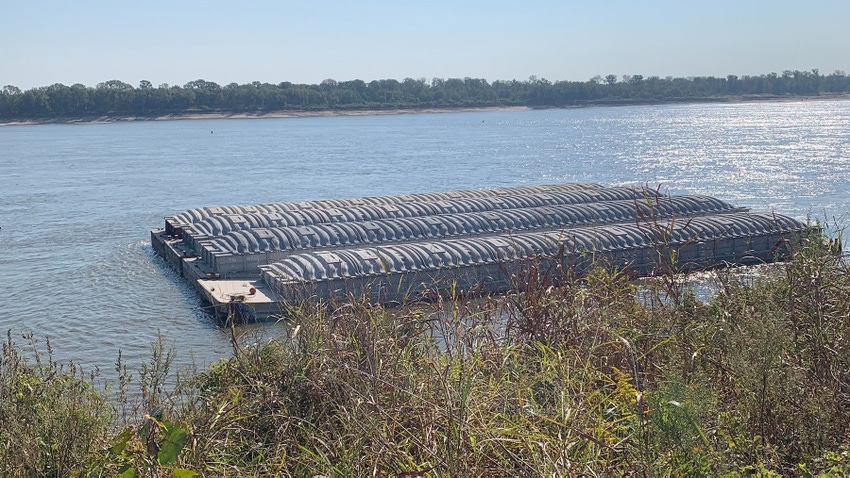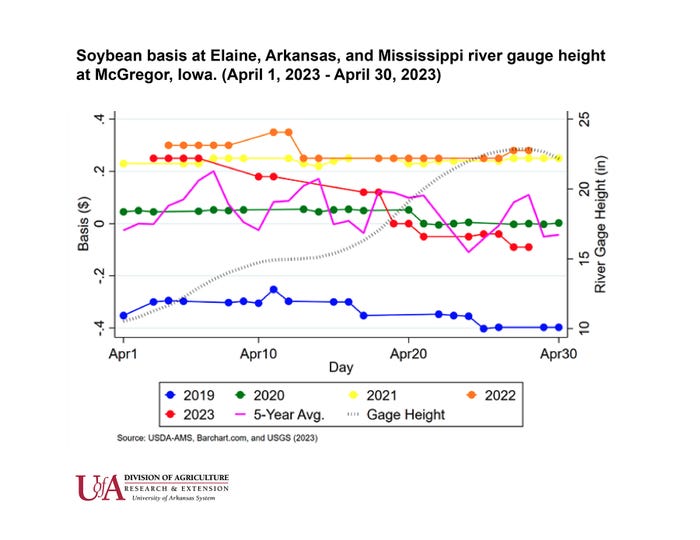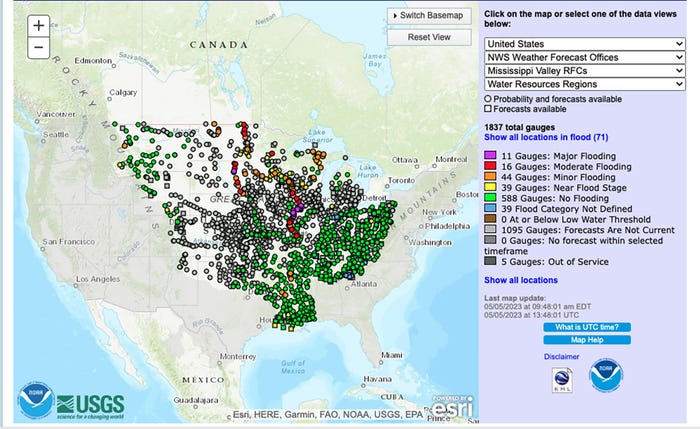May 17, 2023

At a Glance
- Melting snowpack sending Mississippi River levels higher
- 71 river gauges reported minor to major flooding on Friday
Soybean growers might want to take a wait-and-see approach to contracting this spring until the Mississippi River is done carrying melted snowpack downstream, said Hunter Biram, extension economist with the University of Arkansas System Division of Agriculture.
Last October, the Mississippi River dropped to a record low, with barge traffic being halted at one point south of Memphis, Tennessee. With no barge movement, newly harvested grain piled up at the elevators.
“Grain and oilseed producers in the Mid-South experienced record low soybean basis due to reduced barge traffic and record high barge freight rates along the lower Mississippi River,” he said.

Hunter Biram (Kerry Rodtnick , U of A System Division of Agriculture)
Basis is defined as the price difference between the futures price and the cash price of the commodity.
“Grain buyers at local elevators were nudged to bid lower cash prices for soybeans to compensate for the additional cost to transport the grain from the elevator to the port of New Orleans for export,” Biram said. “Further, grain buyers essentially had no place to put the grain even if they wanted to buy it which supports the principle of offering lower cash prices to disincentivize farmers from making delivery.”
Levels swinging
Record levels of snow fell in the north in recent weeks. Duluth, Minnesota, saw 140 inches of snow as of April 30, breaking a three-decade-old record. Minneapolis/St. Paul recorded 89.7 inches, its third-highest snowfall. Bayfield, Wisconsin, on the shore of Lake Superior, saw 182.9 inches of snow as of Tuesday.

All that snow has to go somewhere and a lot of it drains into the Mississippi River. April 28, between St. Paul, Minnesota, and St. Louis, 11 Mississippi River gauges showed major flooding; 16 had moderate flooding and 44 gauges showed minor flooding. High levels can limit barge traffic as “locks and dams are closed preventing the transportation of grain downriver or empty barges upriver,” Biram said.

“While we witnessed the association of record-low basis with record-low river levels in the lower Mississippi River last fall, we are now witnessing an association of relatively lower basis and record-high river levels in the upper Mississippi River due primarily to snow melt,” Biram said.
Biram said that on April 10, soybean basis across the lower Mississippi River “began to diverge from historical trends.”
Using Elaine, Arkansas, as an example, Biram said the basis fell to 18 cents over, down from 25 cents over, “which suggests a local response to the rising upper Mississippi levels.
“This weakening of basis is associated with the increase in river gauge height throughout the month of April,” he said. “The most recent period in which basis fell below zero in April was in 2019 when it consistently stayed near 40 cents under. That was also a period in which the upper Mississippi River experienced record-high levels.”
Good news
As the river level in the upper Mississippi River falls, “with it will most likely come relatively stronger soybean basis in the Mid-South, if the historical association between these two variables continues,” Biram said. “Additionally, forward cash prices typically reach their strongest in early summer before declining as we approach the harvest months.
"One implication for a grain marketing plan would be to consider holding off on the May forward contracting decision for 2023 harvest-time delivery until the latter part of the month in anticipation of recovery to soybean basis,” he said.
Source: University of Arkansas System Division of Agriculture
About the Author(s)
You May Also Like






